If you go visit our friends at FanGraphs, you’ll see that Chris Paddack tops the list of most-searched players. Visit Baseball Savant, and you’ll again find Paddack as a frequently searched player. As you’d have it, he’s also a popular search over at Brooks Baseball. Paddack is a popular name right now because, well, he’s been destroying his competition.
Back in 2016, the Miami Marlins traded Paddack to bolster their bullpen. If you don’t already know, then you may want to sit down (why are you reading standing up?!), because the Marlins traded him for none other than Fernando Rodney. No one likes an armchair general manager, but Paddack joins a laundry list of players the Marlins have jettisoned in exchange for not-great packages. That list includes Giancarlo Stanton, Christian Yelich, Marcell Ozuna, Domingo German, and Luis Castillo. They deserve some credit—they basically stole Caleb Smith, who I wrote about the other day, from the New York Yankees. But this isn’t about any of those players, and it’s certainly not about the dysfunctional Marlins. No, I want to talk about how Paddack has gone from something of a zero to hero.
Upon being traded, Paddack sustained a torn UCL, which subsequently cost him all of 2017. Despite gaudy numbers in 2016 (albeit in Single-A) he was left off of John Sickels’ 2018 top prospect list, and also missed the initial cut for FanGraphs’ top 100 prospect list. FanGraphs ended up boosting him from unranked to #53 on their updated list, and Sickels changed his grade from a C+ to B+ in the middle of 2018, but before that point, it seems only Paddack and the San Diego Padres knew what they had in him.
Let’s go through Paddack’s process. His fastball is what sets everything else up, so we’ll take a peek there first.
Per FanGraphs, highest fastball pVALs thus far:
| wFB/C | wFB | |
| Chris Paddack | 2.60 | 8.8 |
| Tyler Glasnow | 2.40 | 9.2 |
| Mike Minor | 2.30 | 6.9 |
| Madison Bumgarner | 2.09 | 5.7 |
| Jake Arrieta | 2.00 | 7.5 |
Looking at wFB/C (fastball value per 100 pitches), Paddack tops the league. By wFB itself, Glasnow bests the group. Paddack features a relatively fastball-heavy approach, but few throw their fastball with more frequency than Glasnow. Either way, by pitch value, Paddack’s heater has been a premier pitch.
Like so many of the pitchers I’ve written about lately, Paddack’s fastball appears to play best up elevated.
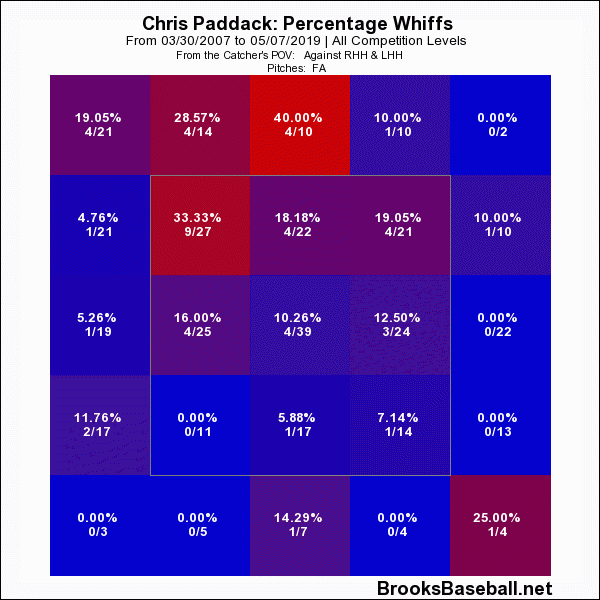
Looking at the number of whiffs per pitches overall, his fastball sees the most whiffs in the upper third of the zone, as well as up and out of the zone.
That’s interesting, because, by spin rate and pitch velocity, Paddack’s fastball looks relatively undistinguished:
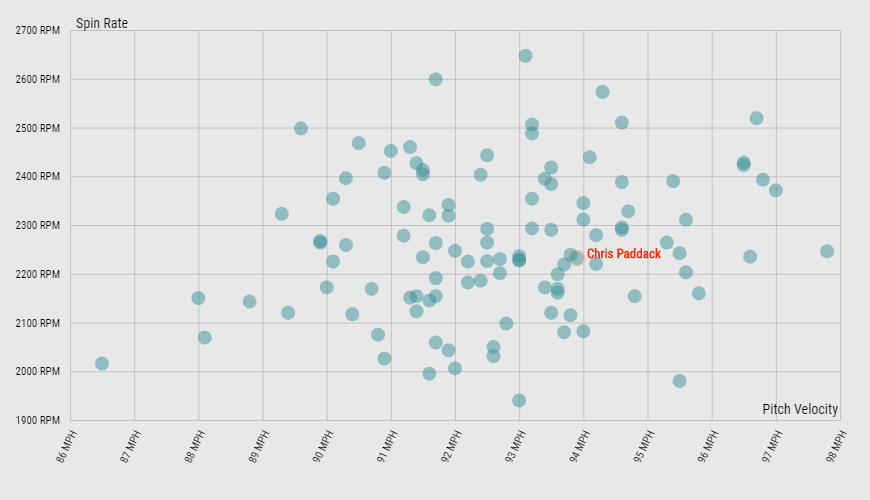
While Paddack’s fastball velocity is in the 72nd percentile, his spin rate is rather ordinary—it ranks in the 44th percentile. So if his spin rate isn’t setting him apart, maybe it shouldn’t be this dominant. Well, I have a few counterarguments to that. But first, drama!
A quote from Paddack on Sunday, regarding Pete Alonso:
“He’s a great player, no doubt. Does he deserve (the Rookie of the Month honor)? Absolutely. But I’m coming for him. We’ll see Monday who the top dog is. That’s something I’m looking forward to, for sure. And I’m not saying that in a cocky way. I’m saying that because I know what I want, just like I’m sure he knows what he wants. It’ll be a fun little matchup.”
And boy was it a fun matchup. On Monday, maybe Paddack started to become more cognizant of how his fastball could play up in the zone. Rather, I think he was more likely just teeming with adrenaline and caught up in the moment. Either way, here are Paddack’s fastest pitches of this year:
- 97.9 mph, fastball to Alonso
- 97.9 mph, fastball to Alonso
- 97.2 mph, fastball to Alonso
- 97.1 mph, fastball to Robinson Cano
- 97.0 mph, fastball to Harrison Bader
- 96.8 mph, fastball to Alonso
- 96.8 mph, fastball to Wilson Ramos
- 96.7 mph, fastball to Cano
Out of the eight fastest pitches of the year for Paddack, seven came against the New York Mets on Monday, and four of them came against Alonso. Here’s the first at-bat, courtesy of Pitcher List’s own Alex Fast:
Paddack vs Alonso round 1 did not disappoint.
At least if you’re a Paddack fan. pic.twitter.com/2vUUxnXILW
— Alex Fast (@AlexFast8) May 7, 2019
Outside for a strike. Inside for a ball. Inside for a strike. Middle-away for a swinging-strike. All fastballs. Alonso would go 0’fer on the night—mostly dominated by Paddack, and also bested by Craig Stammen. Paddack made the NL Rookie of the Month look ordinary.
Here’s what the rest of Paddack’s night looked like, in 12 seconds:
The Sheriff cuffs the Mets.
Chris Paddack – @PaddackChris – sets a new career high with 11 Ks. pic.twitter.com/rs3lhpsByk
— Alex Fast (@AlexFast8) May 7, 2019
Lots of high fastballs and low changeups, which led Paddack to a CSW of 40.7%, trailing only Blake Snell (42.2%) on the day. For the following graphic, I’ve removed curveballs (as he threw just six), but here is the average vertical location for Paddack’s fastball and changeup:
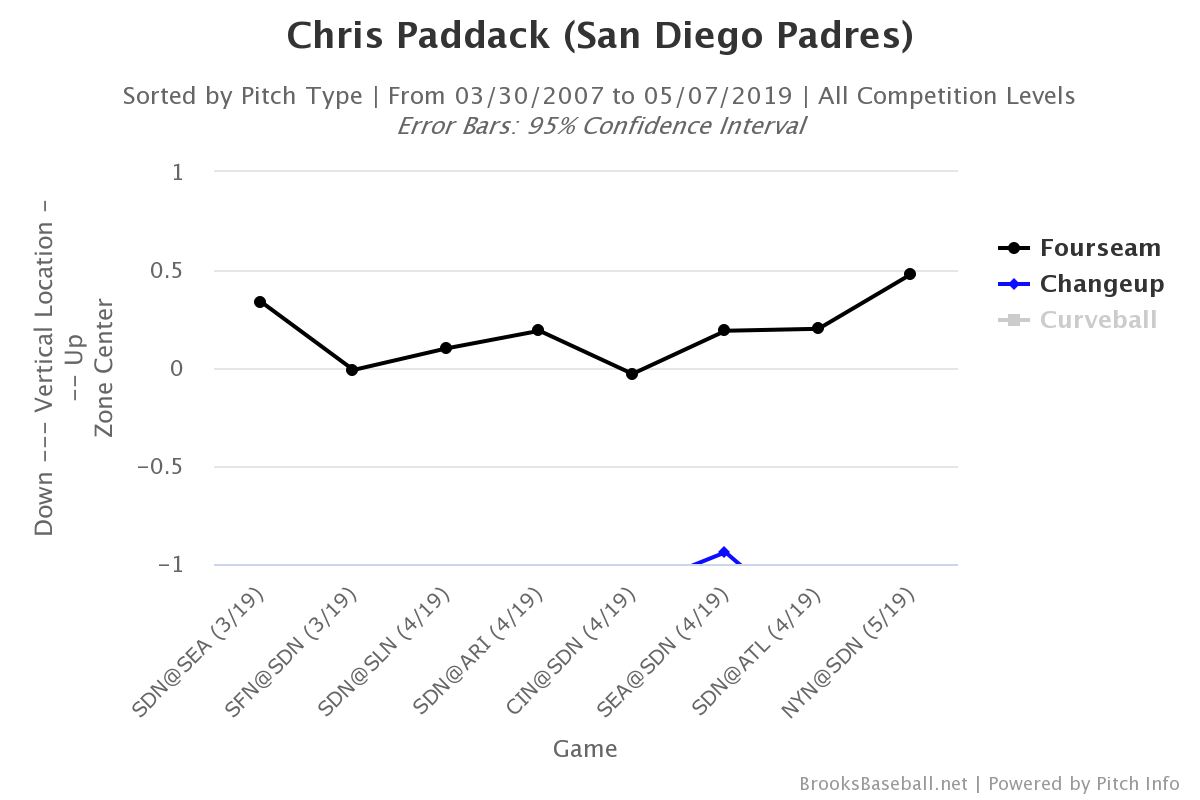
The fastball crept up higher than ever, and the changeup is so low it’s not in the graphic. So, albeit anecdotal, this is evidence that the elevated fastball appears to work for Paddack. He doesn’t grade especially well in spin rate, but his fastball does have some backspin, and according to QOP Baseball, his fastball Rise% is in the 74th percentile, so maybe it makes sense after all.
Using Alex Chamberlain’s pitch leaderboard, I filtered by pitch velocity and pulled the top 21 fastballs (Paddack ranks 21st) and threw them into a spreadsheet. I then divided rpm by mph (also known as Bauer Units) and sorted by it. Among the fastest four-seamers in the league, Paddack’s fastball ranked 12th out of the 21 pitches in Bauer Units—that’s interesting enough, but what intrigued me was the name above Paddack.
| MPH | RPM | Bauer Units | Hmov | Vmov | |
| Trevor Bauer | 94.7 | 2286 | 24.1 | 0.32 | 1.42 |
| Chris Paddack | 93.8 | 2227 | 23.7 | 0.68 | 1.48 |
The inspiration behind Bauer Units himself throws a fastball awfully similar to Paddack’s—although Bauer trades some movement for a superior Bauer Unit. The comparison is an interesting one.
From Baseball Savant, Paddack and Bauer’s repertoires, plotted by movement:
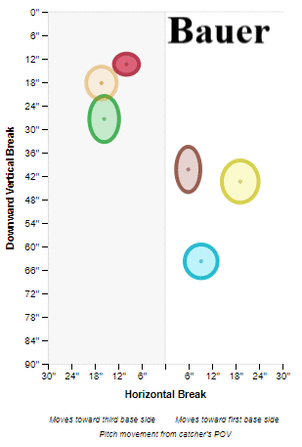
I know it’s hard to ignore Bauer’s extra pitches, but I’ll outline the main differences between the two:
- Their pitches have ever-so-slight differences in movement, but this is ultimately as close as it gets
- Bauer throws his secondaries—especially his curveball—significantly harder than Paddack does
- Bauer has a much fuller pitch repertoire
According to Jeff Zimmerman, here’s how fastballs should play, charting swinging-strike percentage by pitch velocity and rpm:
Real cool from @jeffwzimmerman: SwStr% on FB, spin v velo. For Ks, high everything is good. https://t.co/AgRrLLl66W pic.twitter.com/crmT4Ajump
— Mike Petriello (@mike_petriello) September 12, 2016
According to this chart, we should see a swinging-strike percentage of 7.4% for Paddack, and 8.7% for Bauer. It proves pessimistic, as Paddack and Bauer have swinging-strike rates of 9.8% and 10.1% for their fastballs this year, respectively.
My working theory? Location, and secondary pitches. Another way to frame it: Pitch tunneling.
Paddack and Bauer’s fastball location:
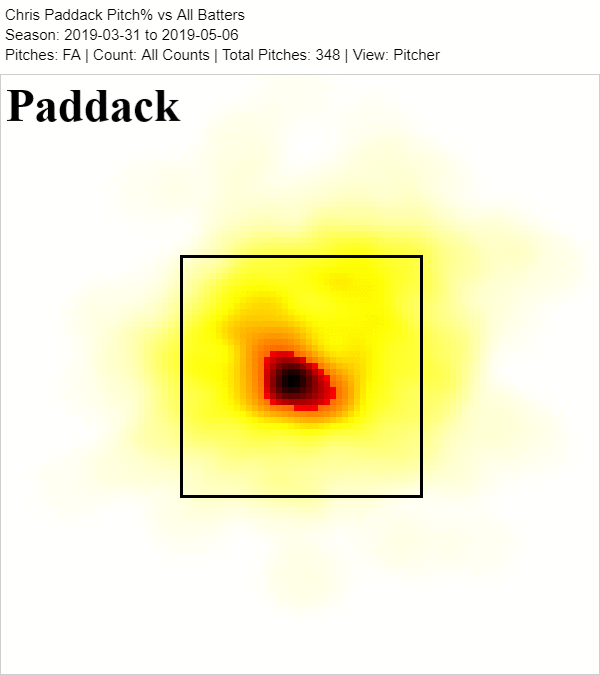
Comparatively, the two generally pitch to the same parts of the zone. Bauer expands the zone a little more vertically (and Paddack more horizontally) but Bauer’s blot is shifted upwards a smidge, which is reflected in the pair’s average vertical fastball location—0.18 for Paddack, and 0.26 for Bauer.
Paddack and Bauer’s fastball location, when ahead:
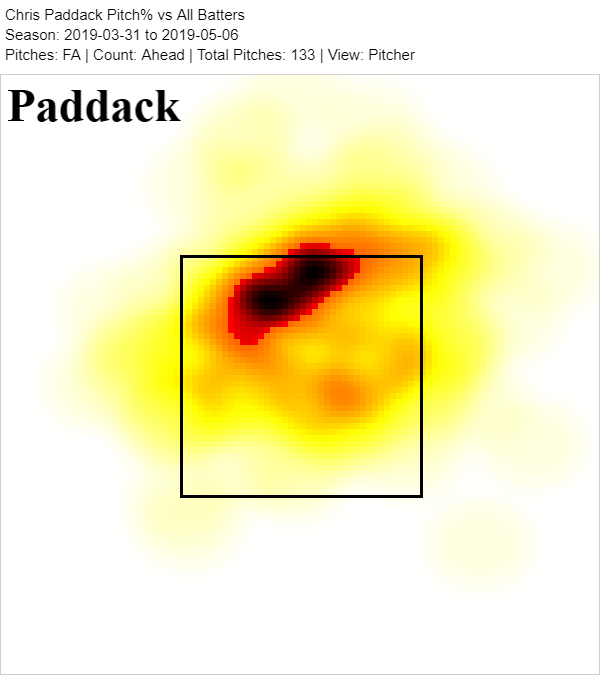
Same idea here, except when Paddack and Bauer get ahead, they go for the kill. While they both quite heavily emphasize the top of the zone, Bauer really climbs the ladder at times (like, seriously, his blot looks like a chiminea), and he also goes glove-side off the plate quite a bit. Also, because of the breadth of his repertoire, Bauer is able to mix up his offerings when he’s ahead, while Paddack is essentially limited to just his fastball and changeup.
What Paddack’s pitches lack in diversity, he makes up for with command. There’s much more to pitching than velocity and spin rate, and Paddack commands his fastball at the top of the zone with the best of them.
https://gfycat.com/AdmirableAptLiger
Sometimes, he’ll send the batter back to the dugout like he did Dansby Swanson. Often times he’ll do this:
https://gfycat.com/IdenticalMeekIntermediateegret
Foul tips are never impressive for anyone, but look at the catcher’s body language. “Yup, that was it. Nice pitch. Let’s do it again.” Paddack follows up with another fastball and then gets the out with a changeup. I removed the audio, but you can hear the commentator at the end of the clip talking about how much faith Paddack has in his fastball, and it’s clear he does. It’s important! By commanding his fastball at the top of the zone, Paddack sets up to do a lot of other things. He’ll get whiffs on his fastball up in the zone, but he doesn’t need to—he just needs to show you the heater.
Here’s what that sets him up to do:
https://gfycat.com/HotCalculatingDipper
Absolute filth below the zone. Paddack can throw below the zone, because hitters will chase, but he doesn’t need to. Here’s why:
https://gfycat.com/TediousCarefreeCuckoo
For a moment, this looks like it’ll be a fastball in, and then it dives down right to the bottom of the strike zone. Gerardo Parra stays on it relatively well, but to avail—Parra cuts on it and whiffs for strike three.
Those are both lovely, but there is one area we’d like to see Paddack experiment with his slowball more:
https://gfycat.com/DisguisedJealousGazelle
Now, Paddack misses here, but the idea behind this pitch is so, so, so good—similar to the last clip, it looks like a fastball in off the plate, and then takes a spectacular dive toward the zone.
And the thing this is, he didn’t even miss! I took the time out to go and find the pitch to Matt Carpenter, because I am incredulous, and I threw a big, beautiful arrow in, to make it that much more obvious that the pitch in question is the green dot:
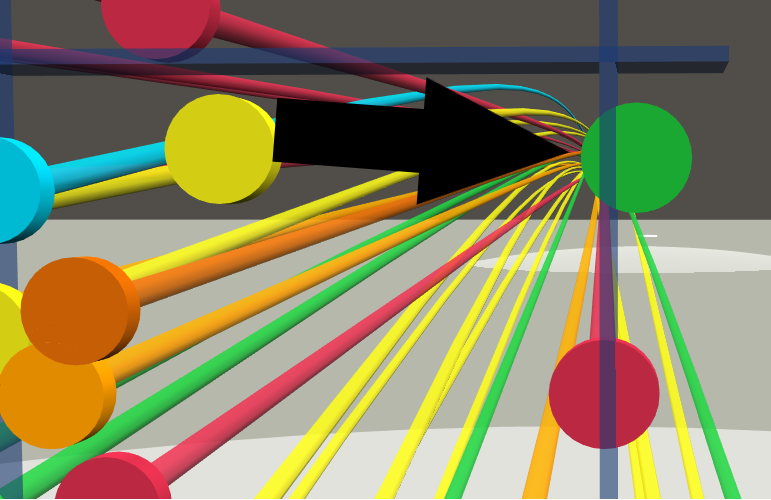
It caught zone, and yet, Carpenter was awarded a free pass to first. Score one for robot ump advocates!
I want to finish up talking about Paddack’s curveball. Here’s his Pitch Plinko, courtesy of Baseball Savant, showing his pitch usage in each count:
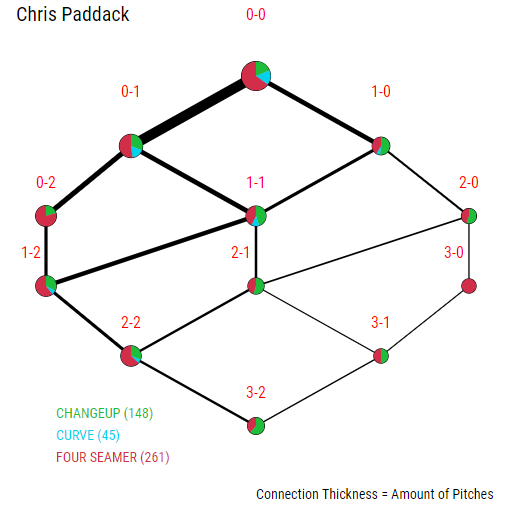
In its current state, Paddack’s curveball is a get-me-over pitch—he uses it early in counts, not as a putaway pitch. That’s because (a) he doesn’t trust his command in the pitch, and (b) it lacks firmness, so it doesn’t get swings and misses. As it progresses—which many think it will—it could become more of an out pitch, but right now he’s sneaking it by hitters for called strikes a couple of times a game. With his fastball and changeup combination, that’s good enough—for now—but it’s hard to be a two-pitch starter, and it will only get more difficult as hitters adjust.
Here’s how Paddack has used it this year:
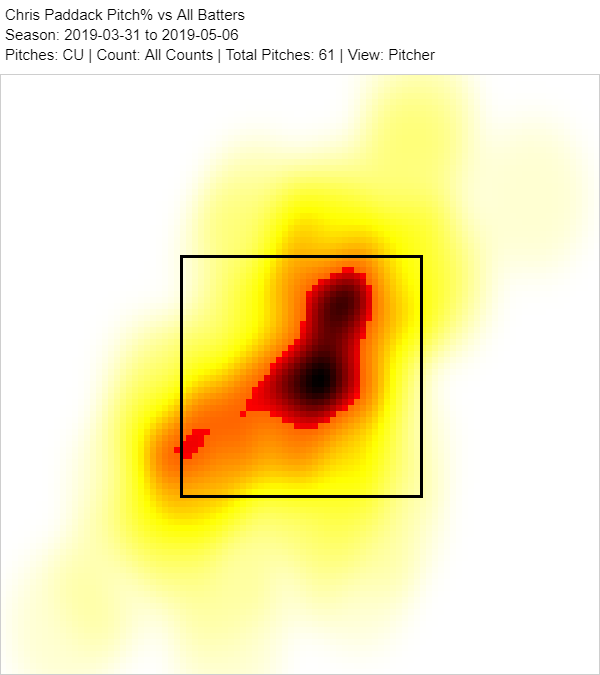
That’s catching an awful lot of plate, and, again, what that tells me—paired with the visual above the heat map—is that Paddack has neither the confidence nor the command (the two are related) that he wants in it. He’s flashed command of it, but if he’s going to throw it more than 10% of the time, he’s going to need to hone it more.
Just in watching him pitch, I’ve seen him miss up quite a bit, and he has yet to be able to locate the ball consistently on his arm-side, especially to righties:
https://gfycat.com/NecessarySmoothDegus
Maybe more importantly, Paddack has tried his darndest to toss his curveball arm-side to lefties:
https://gfycat.com/PastScornfulAgama
Paddack has had some struggles against lefties this year—which is surprising, given his nasty changeup—so getting this curveball working could be a good way to mitigate the differences in his righty/lefty splits. Here, it nabs a called strike on the corner against Omar Narvaez.
I could gush about Paddack all day, but I suppose it’s not all sunshine and rainbows. I mean, it’s mostly sunshine—and his curveball actually does resemble a rainbow—but he’s not perfect. First, his HOTEL spells trouble: his combination of a 5.3% HR/FB, 34 HR/9+, and 116 FB%+—in conjunction with a 61 BABIP+ and 110 LOB%+—indicates that this can’t last forever. Not only that, but Depth Charts (which blends ZiPS and Steamer) has him posting a 3.52 ERA through the rest of the season. That’s fair, as it pretty closely aligns with his 3.31 SIERA and 3.43 xFIP to date. They all like him just fine—in fact, they like him a lot—but they know better than to look past the unsustainable peripherals.
Chris Paddack has a lot to figure out, and yet he’s still been amazing. Even when you bake in some of the inevitable regression for some of his peripherals, he’s been rock solid. It’s hard not to worry about his elbow, and you do wonder if he ever figures out that curveball, but we’re talking about a player who is literally younger than I am (Paddack is 23 years old until next January), and this is his first time pitching above Double-A. Paddack can touch 97 mph and pair it with a filthy changeup, he has elite command, and he knows his weaknesses—he has a lot going for him. Historically, he’s gotten strikeouts, he’s limited walks, and he’s suppressed home runs. I don’t think the latter can keep up—not as he’s done before—but this is a formula for long-term success. Paddack is a 23-year-old pitcher one year removed from Double-A, and three years removed from Tommy John surgery flourishing in the major leagues. What more could you want?
(Photo by Jimmy Simmons/Icon Sportswire)



A+ title and and even better article
‘Preciate it!
I was offered Paddock for G Cole in my 6×6 H2H QS Keeper league and I am really finding it difficult to not accept! What say you?
Umm, are you serious? Don’t accept that lol.
Hold Cole!
Paddack is great, but he’s playing over his head a little bit, and we should see Cole start to come on soon. This would be different if Cole was older, but he’s a top starter, while Paddack has a ways to go.